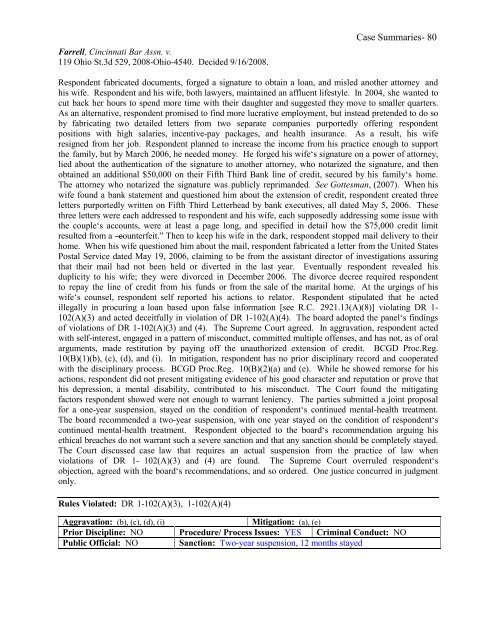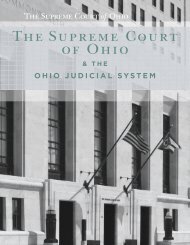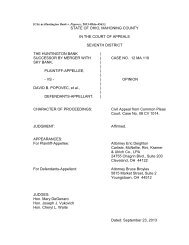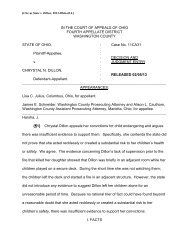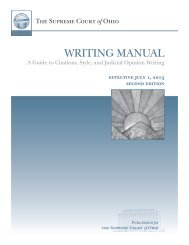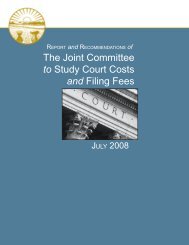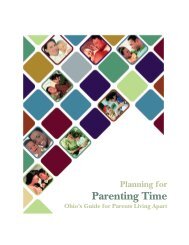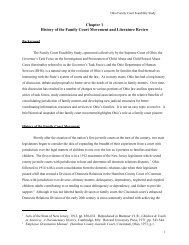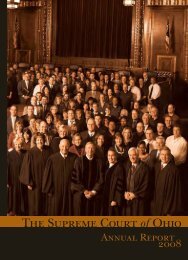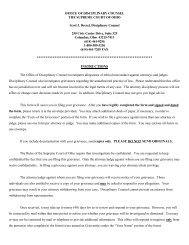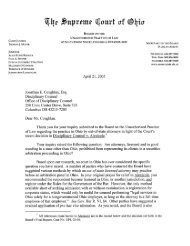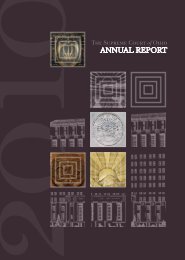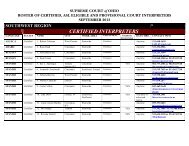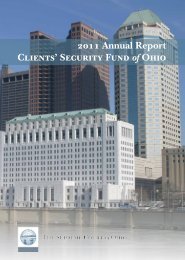disciplinary handbook: volume v - Supreme Court - State of Ohio
disciplinary handbook: volume v - Supreme Court - State of Ohio
disciplinary handbook: volume v - Supreme Court - State of Ohio
You also want an ePaper? Increase the reach of your titles
YUMPU automatically turns print PDFs into web optimized ePapers that Google loves.
Farrell, Cincinnati Bar Assn. v.<br />
119 <strong>Ohio</strong> St.3d 529, 2008-<strong>Ohio</strong>-4540. Decided 9/16/2008.<br />
Case Summaries- 80<br />
Respondent fabricated documents, forged a signature to obtain a loan, and misled another attorney and<br />
his wife. Respondent and his wife, both lawyers, maintained an affluent lifestyle. In 2004, she wanted to<br />
cut back her hours to spend more time with their daughter and suggested they move to smaller quarters.<br />
As an alternative, respondent promised to find more lucrative employment, but instead pretended to do so<br />
by fabricating two detailed letters from two separate companies purportedly <strong>of</strong>fering respondent<br />
positions with high salaries, incentive-pay packages, and health insurance. As a result, his wife<br />
resigned from her job. Respondent planned to increase the income from his practice enough to support<br />
the family, but by March 2006, he needed money. He forged his wife‘s signature on a power <strong>of</strong> attorney,<br />
lied about the authentication <strong>of</strong> the signature to another attorney, who notarized the signature, and then<br />
obtained an additional $50,000 on their Fifth Third Bank line <strong>of</strong> credit, secured by his family‘s home.<br />
The attorney who notarized the signature was publicly reprimanded. See Gottesman, (2007). When his<br />
wife found a bank statement and questioned him about the extension <strong>of</strong> credit, respondent created three<br />
letters purportedly written on Fifth Third Letterhead by bank executives, all dated May 5, 2006. These<br />
three letters were each addressed to respondent and his wife, each supposedly addressing some issue with<br />
the couple‘s accounts, were at least a page long, and specified in detail how the $75,000 credit limit<br />
resulted from a ―counterfeit.‖ Then to keep his wife in the dark, respondent stopped mail delivery to their<br />
home. When his wife questioned him about the mail, respondent fabricated a letter from the United <strong>State</strong>s<br />
Postal Service dated May 19, 2006, claiming to be from the assistant director <strong>of</strong> investigations assuring<br />
that their mail had not been held or diverted in the last year. Eventually respondent revealed his<br />
duplicity to his wife; they were divorced in December 2006. The divorce decree required respondent<br />
to repay the line <strong>of</strong> credit from his funds or from the sale <strong>of</strong> the marital home. At the urgings <strong>of</strong> his<br />
wife‘s counsel, respondent self reported his actions to relator. Respondent stipulated that he acted<br />
illegally in procuring a loan based upon false information [see R.C. 2921.13(A)(8)] violating DR 1-<br />
102(A)(3) and acted deceitfully in violation <strong>of</strong> DR 1-102(A)(4). The board adopted the panel‘s findings<br />
<strong>of</strong> violations <strong>of</strong> DR 1-102(A)(3) and (4). The <strong>Supreme</strong> <strong>Court</strong> agreed. In aggravation, respondent acted<br />
with self-interest, engaged in a pattern <strong>of</strong> misconduct, committed multiple <strong>of</strong>fenses, and has not, as <strong>of</strong> oral<br />
arguments, made restitution by paying <strong>of</strong>f the unauthorized extension <strong>of</strong> credit. BCGD Proc.Reg.<br />
10(B)(1)(b), (c), (d), and (i). In mitigation, respondent has no prior <strong>disciplinary</strong> record and cooperated<br />
with the <strong>disciplinary</strong> process. BCGD Proc.Reg. 10(B)(2)(a) and (e). While he showed remorse for his<br />
actions, respondent did not present mitigating evidence <strong>of</strong> his good character and reputation or prove that<br />
his depression, a mental disability, contributed to his misconduct. The <strong>Court</strong> found the mitigating<br />
factors respondent showed were not enough to warrant leniency. The parties submitted a joint proposal<br />
for a one-year suspension, stayed on the condition <strong>of</strong> respondent‘s continued mental-health treatment.<br />
The board recommended a two-year suspension, with one year stayed on the condition <strong>of</strong> respondent‘s<br />
continued mental-health treatment. Respondent objected to the board‘s recommendation arguing his<br />
ethical breaches do not warrant such a severe sanction and that any sanction should be completely stayed.<br />
The <strong>Court</strong> discussed case law that requires an actual suspension from the practice <strong>of</strong> law when<br />
violations <strong>of</strong> DR 1- 102(A)(3) and (4) are found. The <strong>Supreme</strong> <strong>Court</strong> overruled respondent‘s<br />
objection, agreed with the board‘s recommendations, and so ordered. One justice concurred in judgment<br />
only.<br />
Rules Violated: DR 1-102(A)(3), 1-102(A)(4)<br />
Aggravation: (b), (c), (d), (i)<br />
Mitigation: (a), (e)<br />
Prior Discipline: NO Procedure/ Process Issues: YES Criminal Conduct: NO<br />
Public Official: NO Sanction: Two-year suspension, 12 months stayed


